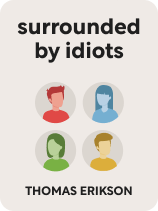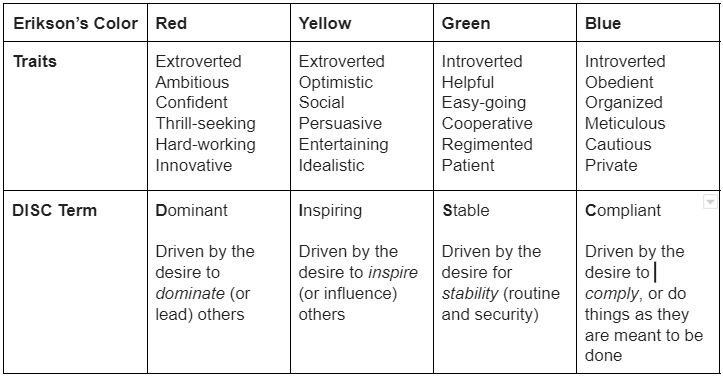

This article is an excerpt from the Shortform book guide to "Surrounded by Idiots" by Thomas Erikson. Shortform has the world's best summaries and analyses of books you should be reading.
Like this article? Sign up for a free trial here .
What are the traits of Thomas Erikson’s four personality colors? What are the negative perceptions of each color?
In the book Surrounded by Idiots, colors are used to break down the most common personalities into four categories: Red, Yellow, Green, and Blue. Red and Yellow personalities are considered to be extroverted, while the Green and Blue personalities are introverted.
Here’s a breakdown of the four colors and the negative perceptions of each.
An Introduction to the Colors
In Surrounded by Idiots, colors are used to describe the four personality types: Red, Yellow, Green, and Blue. Throughout the text, he refers to people by personality type as Red people, Yellow people, and so on. Erikson’s color model is based on the DISC personality-type model, which categorizes people as Dominant, Inspiring, Stable, or Compliant. He explains that he chose to use colors instead of the DISC terms because they are easier to understand, connect to, and remember. Here’s how the two models compare:

| The Psychology of Color Erikson explains that he chose to use colors instead of the DISC terms for ease of understanding, but he doesn’t explain why he chose the colors that he did, or how he assigned them. One field of psychology specifically studies the effect of color on our bodies and minds. The research is highly anecdotal, but enough patterns have emerged that psychologists believe there are some universal truths when it comes to color psychology. Red: One study found a link between the perception of dominance, the color red, and testosterone. The participants (all men) who chose to wear red during a competitive event were determined to have higher levels of testosterone than the participants who chose to wear blue. In a questionnaire, the participants who chose red wrote that they associated the color with dominance and aggression, which they believed would help them in the competition. Yellow: Color psychology says that people associate yellow with optimism, energy, and warmth—very likely due to our relationship with the sun. It has also been shown to cause feelings of frustration and overwhelm when overdone. Green: Green often brings to mind images of nature, which tend to have a calming effect. Green has long been a symbol of fertility and new life because of its connection to spring. Green environments have both water and sunshine, so it is perceived as a safe and nurturing color, where living things will thrive. Blue: Most people associate blue with water, which explains why it brings feelings of serenity and reliability. Unlike plant life, water doesn’t change colors through the seasons; it is always the color you expect it to be. Blue is perceived as conservative and safe, but cold. |
Negative Perceptions of Each Color
This section discusses what others perceive to be weaknesses of each color, or personality type.
Negative Perceptions of Red Personality Types
Overbearing: Red personality types like to be in charge, so if there is a decision to be made, it will be their way or the highway. As a result, Erikson says those working with Red personalities often feel controlled and resent the lack of autonomy.
(Shortform note: There is a theory that the desire to control others begins with “conditioned helplessness” in childhood. A child who isn’t taught to solve problems herself and is instead catered to by her caregivers is likely to grow into an adult who demands more of the same. In these cases, bossing other people around keeps anxiety and low self-efficacy at bay.)
Insensitive: Erikson asserts that this personality type avoids long conversations unless they’re truly interested in the topic, and they’re not subtle when expressing boredom. Most people perceive this behavior as cold-hearted and rude.
(Shortform note: In The Fine Art of Small Talk, Debra Fine gives advice for how to gracefully end a conversation. Rather than ending it abruptly, as the Red personality is inclined to do, Fine recommends you thank or compliment the person, give a reason for your departure, and then follow through with the excuse.)
Negative Perceptions of Yellow Personality Types
Overly talkative: Erikson says Yellow personality types tend to dominate every conversation, and other personality types struggle to get a word in edgewise. Erikson says the other colors (especially the introverted Blue personalities) quickly grow tired of listening to the nonstop talking.
(Shortform note: If you worry that you dominate conversations, try using the traffic light rule: In the first 30 seconds of speaking, you have a green light (your listener’s attention). In the following 30 seconds, you have a yellow light (you may or may not have your listener’s attention). After one minute of speaking, imagine you have hit a red light—stop and give your listener a chance to speak.)
Scatterbrained: Erikson says that this personality type starts a lot of projects that they don’t finish and they tend to have their own organizational systems that others can’t understand. Yellow personalities are often late and they frequently forget deadlines and appointments. For all of these reasons, others perceive them to be scatterbrained.
(Shortform note: Although a Yellow personality type’s chaos may be off-putting, recent studies connect clutter with creativity. In one experiment, participants were divided into two groups and asked to come up with new uses for a ping pong ball. The group that worked in a messy room came up with more innovative ideas for the ping pong ball than did the group that worked in a clean room, leading researchers to believe that disorganized environments benefit the creative process.)
Negative Perceptions of Greens
Lazy: Erikson says that Green personality types take their time mulling over decisions, they prefer to stay home over going out, and they aren’t particularly ambitious. This personality is the least motivated to move, literally and figuratively. This leads the other personality types to characterize them as lazy.
(Shortform note: The correlation between stillness and laziness is an American sentiment not shared by all cultures. Americans are often characterized by other nations as ambitious workaholics who don’t know how to relax. Other countries encourage and celebrate leisure. Italy, for example, has a well-known phrase: bel far niente—“the beauty of doing nothing.”)
Two-Faced: Erikson emphasizes that this personality type avoids conflict like the plague. They care deeply about how others perceive them, so they’re careful not to rock the boat. Erikson notes that this doesn’t mean that Green personalities don’t have opinions of their own. Rather, instead of communicating their grievances directly, they often complain behind the other person’s back.
(Shortform note: If you discover that a coworker has been complaining about you behind your back, start by asking yourself if you contributed to this behavior. Was there something you did or said that made you unapproachable? Confront the person in a straightforward manner but with empathy, ask why he felt he couldn’t come to you directly, and then listen without judgment.)
Negative Perceptions of Blues
Cold-Hearted: Blue personality types like to have space—physically and emotionally. They tend to keep their social circles small, and they prefer to spend time alone or with their families. Their body language is closed off and they don’t do small talk. For these reasons, others often perceive people with this personality to be cold and emotionless.
(Shortform note: “Avoidant attachment” is a term psychologists use to describe people who either avoid relationships or keep their partners at arm’s length. There is an important distinction, however, between avoidant attachment and the personality trait Erikson describes here. One is closed off until she forms a deeper relationship, and the other is closed off within her deepest relationships—often as the result of unresolved childhood trauma.)
Negative: Blue personalities are quick to identify problems but rarely offer solutions (that’s Red and Yellow personalities’ territory). This behavior can drag down morale, but Erikson says people with Blue personality types believe they’re being helpful.
(Shortform note: There’s an adage in business: “Don’t bring me problems, bring me solutions.” Intended to avoid toxic complaining, “solution-only thinking” actually stifles cooperative problem-solving and intimidates employees into not bringing up an issue until it’s a crisis.)

———End of Preview———
Like what you just read? Read the rest of the world's best book summary and analysis of Thomas Erikson's "Surrounded by Idiots" at Shortform .
Here's what you'll find in our full Surrounded by Idiots summary :
- A detailed look at Thomas Erikson's four personality types
- How to navigate conflicts with coworkers
- How to effectively communicate and collaborate with bosses, employees, and colleagues






